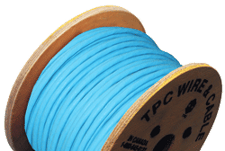Electric wire and cable systems are the lifeline of any industrial application. If one of your cables fail — the entire system comes to a halt, leaving you with costly downtime.
ELECTRIC WIRE AND CABLE CARE
 You have a lot to worry about on a daily basis, don't let wire and cable be one of them. By practicing some general guidelines for electric wire and cable you can extend the life of your cable, reduce downtime, reduce safety and non-conformance issues, and increase your overall efficiency with longer runs.
You have a lot to worry about on a daily basis, don't let wire and cable be one of them. By practicing some general guidelines for electric wire and cable you can extend the life of your cable, reduce downtime, reduce safety and non-conformance issues, and increase your overall efficiency with longer runs.
Common practices for proper wire & cable care include:
1: Choose an Effective Approach
- Choose a suitable cable for the application and its operating environment*
- Use the correct cable size and type that works best for:
- Safety regulations
- Carrying capacity (ampacity)
- Voltage drop
- Ambient temperature
- Mechanical strength
- Expected performance in its environment
- Educate maintenance personnel on cable limitations and what to inspect to reduce cable failures.
2: Prevent Damage
- Avoid kinking or twisting during installation. This can mechanically stress and weaken the conductors.
- Avoid tension & run-overs
- Take note of the minimum bend radius
- Consult electrical wire and cable provider for appropriate recommendations
- Avoid any form of impact or crushing that may damage the jacket
- Keep wire and cable away from any elements the application does not have to be exposed to (such as direct flame).
3: Make Cable Reel Adjustments
- Periodically reverse cable ends to prevent one end from experiencing prolonged exposure to the harsh environment.
- Tie cable to avoid backspooling
- Keep proper tension
- Note potential current overload; expect to derate** a cable if powered while on a cable reel with multiple layers
- Account for voltage drop, if left unaccounted for it may lead to premature machine/motor failure due to overheating.
4: Make Repairs
- Inspect cable and make repairs before the cable completely fails
- Remove cut or crushed cable that leads to unsafe conditions
- Keep spare cable handy to replace damaged cable in place of a temporary fix
5: MAINTAIN Records
- Installation date of electrical wires and cables
- Cause of every failure:
- Highlights exactly where your biggest problem areas occur
- Pinpoints failure at the root of the cause
- Helps form preventative maintenance plan to catch failures before they occur
- Removal of wire and cable for repair(s)
- Cause of every failure:
- Analyze wire and cable performance
PROPER WIRE AND CABLE CARE REDUCES DOWNTIME
DOWNLOAD THE ELECTRICAL WIRE AND CABLE CARE CHECKLIST:
*Harsh environments in electric wire and cable applications can include abrasion, chemicals, extreme temperature, flexing, impact, and tension; or any combination thereof.
**When the cables are used with one or more layers wound on a reel, the ampacities shall be corrected as follows (ANSI/NEMA WC 58-2008, ICEA 5-75-381-2008):
| Number of Layers | Multiplying Correction Factors |
| 1 | 0.85 |
| 2 | 0.65 |
| 3 | 0.45 |
| 4 | 0.35 |




